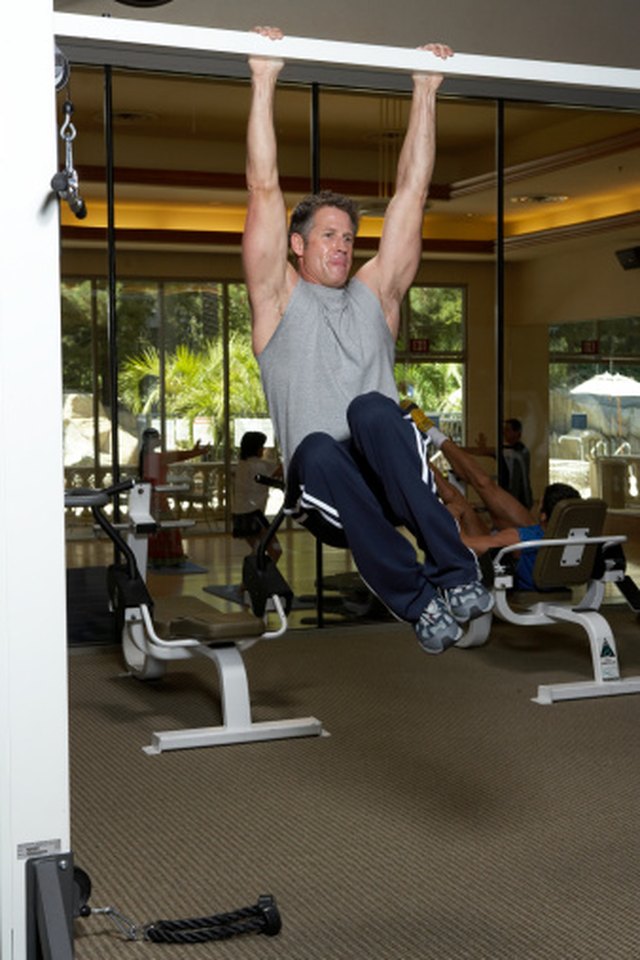Elbow Pain After Pull-Ups

The pull-up is one of the ultimate shows of physical fitness, but it can be hard on your joints if done improperly. Think about the mechanics -- you are not only supporting, but actually pulling your entire body weight into the air, then lowering it back down. Your wrists, elbows and shoulders all remain stationary, so they must move in perfect harmony to avoid mishap. You may need to tweak your fitness routine to prevent elbow pain.
Work Up to Pull-Ups
If you are new enough to pull-ups that you still struggle to do them, you may not be ready for full pull-ups. If the muscles that support your elbow are underdeveloped, your elbow joint and tendons are forced to bear much of the stress, and the weight of your whole body may just be too much. Start with assisted pull-ups on a lower bar, then rest your toes on a chair to do pull-ups on a regular bar. The tiny bit of added support can make a huge difference in the amount of stress placed on your joints.
Overuse
If you are an old pro at pull-ups and do them regularly as part of your exercise routine, you may be doing too much. Pull-ups stress your wrists too, and the pain from that injury may appear in the inner side of the elbow as the tendon becomes inflamed. The condition is called golfer's elbow, but it can occur in anyone who bears weight while clenching something with the hand. It is an overuse injury, meaning it occurs over time as the tendon bears repeated stress. Reduce the frequency of your pull-up sessions or the number of reps you do during each session.
Home Care
Apply ice to ease the pain for the first three to four days, and wrap your elbow for added support. MedlinePlus recommends that you rest it completely for two days and not return to the aggravating activity for three weeks. Over-the-counter pain relievers can help reduce the inflammation, and you should begin to gently stretch your elbow and do range-of-motion exercises after the initial rest period.
When to See a Doctor
If the pain in your elbow gets worse instead of better, make an appointment with your doctor. If the pain is the result of an acute injury, has a new deformity, or is swelling, seek medical attention immediately. If your elbow pain comes back even after you've modified your routine, consult a physical therapist or personal trainer to learn proper form and find out if another exercise may be better suited to your needs.
References
- MayoClinic.com: Golfer's Elbow
- MedlinePlus: Elbow Pain
- Vaquero-picado A, Barco R, Antuña SA. Lateral epicondylitis of the elbow. EFORT Open Rev. 2016;1(11):391-397. doi:10.1302/2058-5241.1.000049
- Amin NH, Kumar NS, Schickendantz MS. Medial epicondylitis: evaluation and management. J Am Acad Orthop Surg. 2015;23(6):348-55. doi:10.5435/JAAOS-D-14-00145
- Blackwell JR, Hay BA, Bolt AM, Hay SM. Olecranon bursitis: a systematic overview. Shoulder Elbow. 2014;6(3):182-90. doi:10.1177/1758573214532787
- Truong J, Ashurst JV. Septic Bursitis. Treasure Island, Fl: StatPearls Publishing; 2019.
- Varacallo M, Mair SD. Proximal Biceps Tendinitis and Tendinopathy. Treasure Island, Fl: StatPearls Publishing; 2019.
- Bellapianta JM, Lavelle WF, Lavelle ED, Onyedika I, Economedes D, Whipple R. Hand Pain. Current Therapy in Pain. 2009:156-167. doi:10.1016/b978-1-4160-4836-7.00021-3
- Moradi A, Ebrahimzadeh MH, Jupiter JB. Radial Tunnel Syndrome, Diagnostic and Treatment Dilemma. Arch Bone Jt Surg. 2015;3(3):156-62.
- Saeed W, Waseem M. Elbow Fractures Overview. Treasure Island, Fl: StatPearls Publishing; 2019.
- Athwal GS. Elbow Dislocation - OrthoInfo - AAOS. OrthoInfo: American Academy of Orthopaedic Surgeons. Oct 2017.
- Bursitis. MedlinePlus. Sept 12, 2019.
- Harvard Health Publishing. The importance of stretching. Harvard Health. Sept 2013.
- Tennis Elbow (Lateral Epicondylitis) - OrthoInfo - AAOS. OrthoInfo: American Academy of Orthopaedic Surgeons. Jul 2015.
- Shah CM, Calfee RP, Gelberman RH, Goldfarb CA. Outcomes of rigid night splinting and activity modification in the treatment of cubital tunnel syndrome. J Hand Surg Am. 2013;38(6):1125-1130.e1. doi:10.1016/j.jhsa.2013.02.039
- Biceps Tendinitis - OrthoInfo - AAOS. OrthoInfo: American Academy of Orthopaedic Surgeons. Feb 2016.
- Kinaci A, Neuhaus V, Ring D. Surgical procedures of the elbow: a nationwide cross-sectional observational study in the United States. Arch Bone Jt Surg. 2015;3(1):13-8.
- American Academy of Orthopedic Surgeons. (n.d.). Elbow Arthroscopy.
- Kane SF. Evaluation of Elbow Pain in Adults. Am Fam Physician. 2014 Apr 15;89(8):649-57.
- O'Connor FG. (2018). Evaluation of elbow pain in adults. Fields KB, ed. UpToDate. Waltham, MA: UpToDate Inc.
- Sources:American Academy of Orthopedic Surgeons (n.d.). Elbow Fractures in Children.
Writer Bio
Andrea Cespedes is a professionally trained chef who has focused studies in nutrition. With more than 20 years of experience in the fitness industry, she coaches cycling and running and teaches Pilates and yoga. She is an American Council on Exercise-certified personal trainer, RYT-200 and has degrees from Princeton and Columbia University.